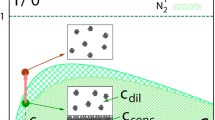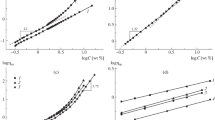Summary
A series of poly-2-vinylpyridine derivatives prepared by partial quaternization of their pyridine groups with alkyl bromide was studied. The ratios of the quaternized pyridine groups were 0, 12.1, 27.9 and 51.2% withre-butyl bromide; 6.4, 8.8, 14.2 and 23.6% withn-hexyl bromide; 6.2, 13.7 and 28.2% withn-octyl bromide; 4.5, 15.0, 24.4 and 30.5% with lauryl bromide. The transition of poly-2-vinylpyridine derivatives from polyelectrolyte to polysoap was examined in an aqueous KBr solution by measuring the light scattering, the viscosity, and the solubilization of Sudan III.
The transition occurred when the quaternization degree or the chain length of alkyl groups was increased. The end-to-end distance per monomer unit determined by light scattering gradually decreases with an increase in the alkyl content or in the alkyl length. It contracts abruptly as the content of octyl bromide increases from 13.7% to 28.2%, and that of lauryl bromide from 4.5% to 15.0%, respectively. These properties suggest that the alkyl groups are brought into the intramolecular aggregation, and therefore the polysoap molecule contracts as a whole. The transition from typical polyelectrolyte to typical polysoap was also supported by the viscosity measurement and the solubilization of Sudan III. The conclusion on this transition is consistent qualitatively with our previous deductions obtained from a statistical treatment of the solution state of polysoaps.
Zusammenfassung
Eine Reihe von Poly-2-Vinylpyridin-Derivaten, hergestellt durch partielle Quaternisierung ihrer Pyridingruppen mit Alkylbromiden, wurde untersucht. Der Anteil an quaternisierten Pyridingruppen betrug 0, 12.1, 27.9 und 51.2% mit n-Butylbromid; 6,4, 8,8, 14,2 und 23,6% mit n-Hexylbromid; 6,2, 13,7 und 28,2 mit n-Octylbromid; 4,5, 15,0, 24,4 und 30,5% mit Laurylbromid. Der Übergang von diesen Poly-2-Vinylpyridin-Derivaten vom Polyelektrolyt zur Polyseife wurde in wäßriger KBr-Lösung mit Lichtstreuung, Viskosität und Solubilisation von Sudan III geprüft. Der Übergang fand statt bei Erhöhung des Quaternisierungsgrades oder der Kettenlänge der Alkylgruppen. Der End-zu-Endabstand der Monomereinheit, bestimmt mit Lichtstreuung, nahm langsam mit Anstieg des Alkylgehaltes oder der Alkyllängen ab. Er kontrahiert sich abrupt, wenn der Gehalt an Octylbromid von 13,7% auf 28,2% und der von Laurylbromid von 4,5 auf 15,0% ansteigt. Dies läßt vermuten, daß die Alkylgruppen zu einer intramolekularen Aggregation kommen und somit das Polyseifenmolekül sich als Ganzes kontrahiert. Der Übergang vom typischen Polyelektrolyten zur typischen Polyseife wird auch durch die Bestimmung der Viskosität und der Solubilisierung von Sudan III gestützt. Die Folgerung aus diesem Übergang ist qualitativ konsistent mit den vorangehend gegebenen Ableitungen aus einer statistischen Betrachtung des Lösungszustandes von Polyseifen.
Similar content being viewed by others
References
Strauss, U. P. andN. L. Gershfeld, J. Phys. Chem.58, 747 (1954).
Strauss, U. P., N. L. Oershfeld, andE. H. Crook, J. Phys. Chem.60, 577 (1956).
Strauss, U. P., andB. L. Williams, J. Phys. Chem.65, 1390 (1961).
Woermann, D., andF. T. Wall, J. Phys. Chem.64, 581 (1960).
Nakagawa, T., andH. Inoue, Kolloid-Z. u. Z. Polymere195, 93 (1964).
Fuoss, R. M., andU. P. Strauss, Ann. N. Y. Acad. Sci.51, 836 (1949).
Strauss, U. P., andE. G. Jackson, J. Polymer Sci.6, 649 (1951).
British Standard 188 (1937).
Brice, B. A., M. Halwer andR. Speiser, J. Opt. Soc. Amer.40, 768 (1950).
Kuriyama, K., H. Inoue, andT. Nakagawa, Ann. Reports Shionogi Research Laboratory9, 1061 (1959).
Kuriyama, K., Kolloid-Z. u. Z. Polymere180, 55 (1962).
Debye, P. P., J. Appl. Phys.17, 392 (1946).
Nakagawa, T., K. Kuriyama, M. Inaba andK. Tori, Nippon Kagaku Zasshi77, 1563 (1956).
Huggins, M. L., J. Amer. Chem. Soc.64, 2716 (1942).
Cragg, L. H., andR. H. Sones, J. Polymer Sci.9, 585 (1952).
Cragg, L. H., andC. C. Bigelow, J. Polymer Sci.16, 177 (1955).
Yamakawa, H., J. Chem. Phys.34, 1360 (1961).
Flory, P. J., “Principles of Polymer Chemistry”, Chap. 14 (New York) 1953.
Inoue, H., Part II of this series (to be submitted to Kolloid-Z. u. Z. Polymere).
Kirkwood, J. G., andR. J. Goldberg, J. Chem. Phys.18, 54 (1950).
Stockmayer, W. H., J. Chem. Phys.18, 58 (1950).
Zimm, B. H., J. Chem. Phys.16, 1093, 1099 (1948).
Stacey, K. A., Light-Scattering in Physical Chemistry, Chap. 2 (London) 1956.
Ref.18, Chap. 10.
Gellert, M. F., andS. W. Englander, Biochem.2, 39 (1963).
Fuoss, R. M., Discuss. Faraday Soc.11, 125 (1951).
Author information
Authors and Affiliations
Rights and permissions
About this article
Cite this article
Inoue, H. Polysoaps derived from poly-2-vinylpyridine. Kolloid-Z.u.Z.Polymere 195, 102–110 (1964). https://doi.org/10.1007/BF01503657
Received:
Issue Date:
DOI: https://doi.org/10.1007/BF01503657




